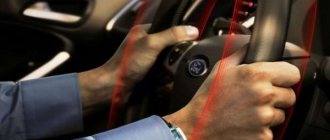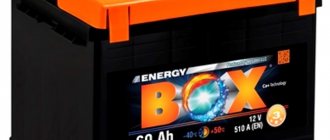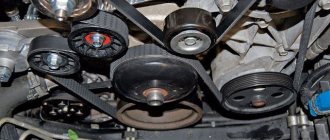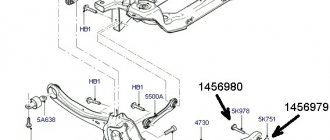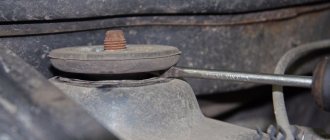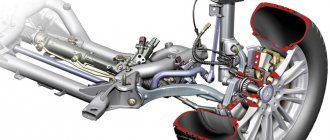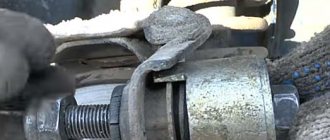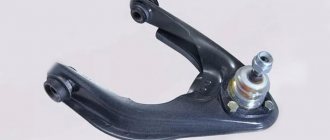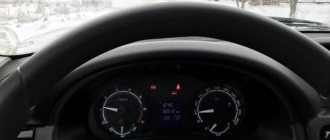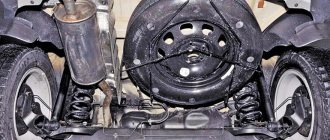The design of the rear suspension is somewhat simpler than the front. But that doesn't mean she can't knock. Knocks from the rear of the car often become audible already at the moment when it is urgent to go to a service station and have the car repaired. In the front part we usually hear feedback on the steering wheel or pedals, on the body, and just sounds closer. In the rear, the sound can be transmitted into the trunk, where it is completely inaudible. And so, once every ten years, the driver needs to transport something long, and he folds the back of the rear seat. The knocking immediately becomes noticeable, and an understanding of the presence of a problem comes. And if in the front suspension you can directly determine by the nature of the knock what exactly is happening to the car, then in the rear it is much more difficult to do all this. There are certain diagnostic methods, but in general, understanding the cause of knocking noises is not so easy.
It is best to use the manual diagnostic method if you cannot go to a service station. There are also diagnostic stands that accurately perform high-quality tasks of identifying any problems in the suspension system. You can go to a good specialist who works somewhere in a garage and save money on repairs, but for such a step this specialist must be familiar or recommended to you. Otherwise, you should not use such services. Driving with a knock in the rear and thinking that this suspension is not so important in a car is not entirely correct. A variety of problems are possible that can lead to unpleasant consequences. There are a number of reasons to consider. Let's look at the details that you should pay attention to when diagnosing yourself.
Knock in the rear suspension - find and eliminate the cause of the sounds
The design of the rear suspension is somewhat simpler than the front. But that doesn't mean she can't knock. Knocks from the rear of the car often become audible already at the moment when it is urgent to go to a service station and have the car repaired. In the front part we usually hear feedback on the steering wheel or pedals, on the body, and just sounds closer. In the rear, the sound can be transmitted into the trunk, where it is completely inaudible. And so, once every ten years, the driver needs to transport something long, and he folds the back of the rear seat. The knocking immediately becomes noticeable, and an understanding of the presence of a problem comes. And if in the front suspension you can directly determine by the nature of the knock what exactly is happening to the car, then in the rear it is much more difficult to do all this. There are certain diagnostic methods, but in general, understanding the cause of knocking noises is not so easy.
It is best to use the manual diagnostic method if you cannot go to a service station. There are also diagnostic stands that accurately perform high-quality tasks of identifying any problems in the suspension system. You can go to a good specialist who works somewhere in a garage and save money on repairs, but for such a step this specialist must be familiar or recommended to you. Otherwise, you should not use such services. Driving with a knock in the rear and thinking that this suspension is not so important in a car is not entirely correct. A variety of problems are possible that can lead to unpleasant consequences. There are a number of reasons to consider. Let's look at the details that you should pay attention to when diagnosing yourself.
Worn support bearing
https://www.youtube.com/watch?v=upload
These sounds appear in the same way as with an inelastic damper, but they are sharper and much louder. In order to make an accurate diagnosis in this case, it is necessary to remove the stand. It is recommended to take into account one rather interesting feature that is inherent in such breakdowns: bearing wear is always uneven.
So, maximum wear. where it is constantly located when the car is driving straight. If after turning the steering wheel the knocking noise disappears for a while, then it is definitely a support bearing.
There is also another diagnostic method. It is quite old, but effective. You will need an assistant again.
The second person should rock the machine up and down. At this time, the driver should feel the shock absorber rod with his hand. The knock will be transmitted to this rod.
If you compare these knocks in the front suspension when turning the wheels at different angles, you can draw some conclusions about the condition of the support bearing.
Another possible reason is that the nut on the upper support is loosely tightened, sometimes this happens.
Suspension arms or beam - check fastenings and silent blocks
One of the common causes of knocking in the rear suspension is the beam. If your car has such a suspension design, it is worth determining the exact location of the knock. To do this, you need to put the car in a pit, ask someone to rock the car, and in the pit, grab hold of various places on the beam with your hand. Most often we are talking about the knocking of the silent blocks of the rear beam. The suspension arms may also knock, and here the diagnosis will be somewhat more complicated:
- you need to install the car in the pit, putting it on speed, and not on the handbrake, then climb into the pit, taking with you a pry bar, a large screwdriver, and a set of keys;
- using a mount, check the functionality of the bushings and silent blocks; if they move easily in their seats and noticeably play, they need to be replaced;
- check the integrity of the suspension arms, their bending can lead to knocking and uneven running of the car, and cracks indicate the need for quick replacement;
- the fastenings of the levers can be loose, for this you need to use keys and tighten all visible connections, this will help eliminate this item from the causes;
- When the suspension elements are deformed, the levers themselves can knock on body parts and other elements of the rear suspension space while driving, so you can rock the car and find out.
A fairly simple diagnosis of the rear suspension by rocking the car helps to obtain information about the condition of your car very simply and without any problems. However, it is not always possible to actually obtain data on the state of the suspension, since vehicles do not always reveal all the secrets from simple rocking. It may well be that there is a knock on the road, but there is none at the service station. So another diagnosis may be required.
Checking the levers
The car is driven into the pit and a gear is installed at the gearbox - in this case it is better not to use the handbrake. For diagnostics you will need a mount. With its help, the serviceability of silent blocks and bushings in the levers is checked. If there is play, then the bushings need to be changed.
The suspension arms need to be checked for integrity. Often these parts become deformed when driving. This can lead to a knocking sound in the rear suspension. Cracks will indicate the need for urgent replacement of the levers. The fasteners of the levers may loosen during driving - if this is the case, then they are tightened.
Deformed levers may knock on the body when driving. Other parts in the rear suspension also make noise. This is determined by the rocking of the car.
This simple diagnostic method by swinging allows you to quickly and without serious costs obtain the most complete information about the condition of the suspension. But you shouldn’t expect a miracle - a car won’t always reveal all its secrets so easily. It happens that you can hear a knock from the rear suspension while driving, but in a pit or at a service station you can’t hear anything.
Racks and rack fastenings, supports and other mechanisms - we check
If the rack is knocking, you can determine it more or less simply. At the moment of swinging, you need to attach the hammer handle, for example, to a stand and see if the knock is transmitted to the attached object. It is quite possible that the spring is knocking, which has become deformed and has sagged. It is also possible to get a knock when the rack mounts come loose. There are such problems in these nodes:
- the upper mount of the strut in the form of a support has broken, this can be determined by opening the trunk and placing a finger on the mount, and then rocking the car up and down;
- the lower mount has lost its elasticity, this is also easy to check using the same operation, but only in a hole under the car - put your hand on the mount;
- the strut itself has failed, you can determine this by eliminating all other options and problems with the suspension, then the shock absorber on your car will need to be replaced;
- Next, it’s also worth checking the spring, which can make different sounds, the coils can hit each other, there are a number of other problems that break the spring;
- For a full diagnosis, it is possible to remove the rack and then disassemble the parts with separate diagnostics, but this is carried out at a time when nothing else helps.
It often happens that everything is in order during diagnostics, but while driving the car makes a knocking noise. In this case, you will have to disassemble the rear suspension mechanism. We would like to immediately warn those motorists who want to do this themselves. This is not the best option, since you need to fully understand each rear suspension component in order to then install all the parts in the normal sequence. Otherwise, you cannot avoid problems.
Brake calipers - an exclusive problem
Only in some car models with disc brakes in the rear, the brake calipers become loose or simply play. This is problem number one for all budget cars with rear disc brakes. It is the budget nature of fasteners that often causes parts to fail. It is very interesting that calipers can be an invisible cause of knocking, that is, very difficult to diagnose. You will have to perform the following procedures:
- first, you can try to pull the caliper with your hands while the wheel is installed; perhaps the parts of the mechanism are hitting the disc, everything should be tightly screwed;
- Next, you should remove the wheel and carry out manual diagnostics of all possible fastenings of this unit; you should tug the mechanism with your hands to understand the absence of play;
- the next step should be to disassemble the caliper to determine the loose parts, but doing this without experience is not recommended, as many problems can be found;
- when disassembling, you should pay special attention to the quality of tightening of each module and each bolt, this is what can tell you where the knocking problem lies;
- when reassembling, pay attention to the pads; it is quite possible that they are worn out or deformed, and are simply knocking in the places where they are installed during operation.
These are the types of brake problems that can arise in a modern car. This rarely happens in the absence of unprofessional intervention, but it is quite normal on budget cars. With a drum brake system, everything is much simpler; in this case, not a single mechanism can knock. Unless the entire brake drum fell apart, the pads and other parts flew out. This can only be checked by disassembling the entire mechanism.
What else could be knocking in the back of the car?
There are the most unusual types of knocking noises that many drivers have been looking for for years and cannot find. If the suspension knocks, the knock sooner or later begins to intensify and localizes itself. That is, you will soon be able to understand where exactly the car is knocking. But if the knocking is monotonous and does not change, there is a real point in carrying out additional checks. These checks consist of discarding the most incredible options for knocking in the rear of the car:
- the wheel has come loose - this is possible after going to a low-quality tire service; if the wheel is not tightened, it can not only knock, but also fly off at speed;
- There are several metal parts lying in the trunk and actively knocking against each other, but it seems to you that we are talking about knocking directly in the chassis or other systems;
- the spare tire is knocking on a specially designated place for it - place rubber bands under it or simply turn it over, this will help eliminate the knocking, if any, in this unit;
- body parts may knock, if the spot welding has failed or any bolts securing body elements have become loose, the knocking may be annoying;
- The muffler often breaks off the rubber bands and begins to drum on the bottom of the car or the gas tank; this can be easily checked by driving the car into a pit and pulling the muffler in different directions.
Let's sum it up
There are many interesting options for car repair. Among them there is also self-diagnosis. This is a great advantage for every owner that you can do your own research on the car, detect problems, and go to the service already prepared for all the nuances. Our modern service stations do not always tell the truth about problems, make incorrect diagnoses and make money out of the blue. This is why there is an outflow of customers to garage foremen. Sometimes the latter offer much better quality of services.
There are indeed many complex elements in the rear suspension, and sometimes it is very difficult to diagnose. But in fact, you just need to gain a little experience in order to more or less understand the details of the chassis. This will help you simply carry out the necessary actions and get a more or less good inspection of the car yourself. If you have a master whom you completely trust, it is better to contact such a specialist. This will help you find the cause much faster and perform high-quality repairs in a matter of hours. How do you prefer to detect the causes of knocking noises in your car's suspension?
Spherical bearing
On car forums, in topics dedicated to this knock, a variety of reasons for knocking in the front suspension are discussed. Ball joints are one popular reason. One can say even more - this is a classic among all possible sources of extraneous knocks.
But there is one peculiarity here. On front-wheel drive cars, knocking noises from ball joints are very rare. It is more typical for classic VAZ models.
Thus, a worn joint can cause sharp vibrations when crossing small irregularities in the road. It is quite easy to diagnose this malfunction - pull the front wheel in a transverse direction. Naturally, it is advisable to lift the car for this.
Rear suspension design
In order to determine what could be knocking in the suspension, you should know what this element of the car consists of.
- Guide structure.
- Twisted coil springs.
- Shock absorbers.
- Rubber bushings and mounting cups.
A sound in the rear suspension may appear when one of the above elements fails. At the same time, we note that if there is a constant knocking, it is imperative to carry out diagnostics of the suspension. If working with a car causes many problems, then you can entrust the diagnostics to specialists from a car service center. Note that the rear suspension has a very simple design and you can dismantle the worn part yourself.
Possible causes not related to suspension
Before determining what might be knocking, you should make sure that there is a problem with the suspension. Often, a knock may appear due to a minor malfunction of another element, but with strong vibration on the road, it seems that the problem is with the chassis elements. Possible causes of knocking include the following:
- The exhaust pipe in most cases becomes the cause of the knocking, as its fastening wears out over time.
- poorly secured items in the cabin or luggage compartment. You need to check the contents of the trunk, especially the mounting of the spare wheel. If during the first inspection no obvious problems are identified, we proceed to diagnosing the suspension.
Rack diagnostic methods
There are a lot of methods. The classic one is to swing the body down, and it should smoothly rise to its normal position and stop. If everything is so, then the rack is working.
It happens, although quite rarely, that the strut makes extraneous sounds due to its internal problems, for example, the nut that holds the piston has become unscrewed. However, this does not cause knocking. When driving, the car sways and controllability decreases.
https://www.youtube.com/watch?v=ytaboutru
In this case. strut replacement and suspension repair.
Various shock absorber breakdowns are the consequences of its improper use. The oil in these systems must have a special specific viscosity, which also depends on the air temperature. Having warmed up the engine, the driver immediately takes off, but the oil in the rack has not warmed up.
If it’s frosty outside, then the viscosity in the stand is too high. In this case, thin and very fragile parts fail.
Thick oil may also not be related to the weather. Sometimes excessively thick liquid is poured into shock absorbers. This is done to increase the resistance force and so that the oil does not “run away”. But as a result, stability and controllability deteriorate, because hard does not mean good.
Diagnostics of suspension guides
Many cars have a similar rear suspension design, which makes diagnostics and dismantling easier. The differences can only be in the principle of fastening and the type of installed parts. During the diagnosis you should:
- We check the force of the beam, if there are levers. As a rule, due to severe wear, cracks appear, which cause deformation.
- If the hinges are too worn, they can also cause a knocking noise from the rear. Cracks may appear on the hinges, which cause their deformation.
The threaded connection of the flanges used when attaching the guide elements can also cause a problem. The flanges can be repaired, but it is recommended to install new ones. The check is carried out on an overpass or pit, since problems are determined visually or using force (that is, you need to strongly loosen the guide elements with your hands). This will require good lighting. Therefore, it is recommended to carry out work in the garage.
Diagnostics
The weakest and most vulnerable point in the front suspension of the second generation Ford Focus is considered to be the silent blocks of the lower arm.
The problem is that it will not be possible to replace it either on your own or at most stations, since such an operation requires special equipment. It is for this reason that a banal failure of the silent block requires replacing the entire lever. On average, they run up to 100,000 km. Shock absorbers have approximately the same service life. The stabilizer struts on the Ford Focus and steering tips are more durable - they can withstand up to 130,000 km. Wheel bearings will have to be replaced every 50,000 km. In order to check the condition of the suspension, it is necessary to drive the car onto an overpass or pit, lifting each wheel in turn. It is recommended to perform such diagnostics at least once every 20,000 km, or after hitting serious potholes. There is no point in waiting for a knock or squeak to appear.
So, let's start with the wheels:
- We unscrew them with our hands and observe: the rotation should be without jerking, without jamming or extraneous noise.
- We take turns holding the wheel with our hands from below and from above, and press in different directions.
If during the last check there is a knock, creaking or play, then something is wrong. If the play disappears when you press the brake, the problem is in the wheel bearing. Next you need to check the ball joints. To do this, insert a screwdriver between the suspension arm and the steering knuckle, moving it to the side. If there is play, then the balls need to be changed. Subsequently, it is also necessary to check the silent blocks and ball joints at the anti-roll bar struts.
Generally speaking, the main reason for knocking and creaking in the suspension is bad roads. Constant impacts, driving over potholes and potholes - all this leads to problems (knocking, creaking) in the front suspension that require repair.
Spring problem
Although springs are very durable, they can also wear out over time under certain operating conditions. Often, spring wear manifests itself in a slightly different way: the car wobbles at high speed, strong rocking, or a sagging rear end. However, when looking for something that may be knocking, you can conduct a visual inspection and pay attention to the following points:
- Do the turns have any defects?
- Are the rubber pads intact?
In most cases, springs lose their elasticity due to long service life or when exposed to heavy loads (for example, a passenger car has been used for a long time to transport a heavy load). The appearance of defects in the turns indicates poor quality of the metal used in manufacturing, a manufacturing defect, or severe wear. If everything is in order, we carry out further inspection.
Shock absorbers: a common problem caused by rough roads.
Shock absorbers can be considered the most vulnerable structural element. They are designed to absorb impacts when overcoming broken sections of the road. You can determine shock absorber wear as follows:
- Visually - if a clear oil leak appears, as indicated by oil stains, this structural element must be replaced or repaired.
- Completely disassemble the shock absorber. To do this it is necessary to dismantle them. There are rubber bushings inside the shock absorber that often fail. The problem with shock absorbers manifests itself when overcoming bumps. There may also be poor vehicle stability when driving at high speed. It is worth considering that the method is only suitable for serviced shock absorbers.
Other reasons
If diagnostics have been started and no obvious problems have been identified, you can pay attention to the following:
- A brake caliper is an element of the brake system, which, when the pedal is pressed under the influence of the created pressure in the brake hydraulic system (mechanical and electronic are quite rare), compresses the wearing pads. In some cases, misalignment is possible, due to which the pads will wear unevenly and a knock may appear during braking. You can check the caliper visually, as it should also have no defects.
- The hub or bearings are a common problem that leads to humming and knocking noises while driving. To check, the brake disc or drum must be removed. If installed bearings are severely damaged during dismantling, they spill out or have defects that can be identified visually. The bearing mounting method is pressing. That is why, when it gets wedged, the hub can wear out, as evidenced by the bearing turning. You can determine problems with the hub or bearings without dismantling work, for which you need to slightly rock the wheel to the side.
- Another sign is a loose wheel. Wheel rims need to be balanced.
Consequences of ignoring a knock
Any extraneous sounds that appear while driving must be identified without delay, as their presence may indicate a serious malfunction. In this case, let’s look at the consequences of knocking in the rear suspension:
- If problems arise in the guides and are not resolved in a timely manner, in addition to material costs, controllability may deteriorate; in some cases, this malfunction leads to a situation where the suspension is secured only by a spring and a shock absorber. The result is wear and tear of all elements, creating an emergency situation.
- If the spring is damaged, the car sways on uneven roads. In addition, the spring does not limit the movement of the shock absorber. The result of spring wear is terrible stability of the car on the road and damage to other suspension elements.
- Failure of shock absorbers is accompanied by a constant knocking sound. As a result, severe wear occurs on the fastening elements, as well as the shock absorbers themselves. In this case, controllability deteriorates significantly, and strong roll is possible when turning at high speed.
In most cases, a knock in the rear suspension is detected almost immediately, as it occurs while overcoming a bump or pothole on the road. As a rule, suspension elements fail after their service life has expired. If you replace parts in a timely manner, you can avoid road accidents and serious material costs.
Knocks in the suspension and transmission of Ford Focus 2: description of the problem, how to deal with it.
If extraneous knocking noises appear in the suspension of a moving vehicle, it is necessary to immediately determine their source, regardless of whether the knocking is constant or appears only when driving over uneven surfaces. Warning Faults in the vehicle's suspension can lead to a serious accident!
Ford Focus suspension knocking 2:
If extraneous knocking noises appear in the suspension of a moving Ford Focus 2, you must immediately determine their source, regardless of whether the knocking is constant or appears only when driving over uneven surfaces.
What can knock from behind in a car?
- Registration
- Entrance
- To the beginning of the forum
- Forum Rules
- Old design
- FAQ
- Search
- Users
never buy SAAZ racks.
Are the springs not touching?
maybe the spare tire is bouncing? or where does the hardware “play”?
The crusher also prolaeil - he shouldn’t hurt.
take a better look. and if there is a dull knock, the rear seats may be knocking vertically. When do passengers sit in the back, is there a knock?
I'm already getting a knock from behind, a dull sound on the body, like a rubber hammer.
I have already replaced the shock absorbers, the silent on the beam, the upper rubber bands on the struts.
What a . hits from the right behind on small bumps.
I'm already getting a knock from behind, a dull sound on the body, like a rubber hammer. I have already replaced the shock absorbers, the silent on the beam, the upper rubber bands on the struts. What a . hits from the right behind on small bumps.
Information on icons and features
You can not
start topics You
cannot
reply to messages You
cannot
edit your messages You
cannot
delete your messages You
cannot
vote in polls You
can
attach files You
can
download files
Knock in the front suspension
Unfortunately, it is impossible to determine by ear what is actually knocking. Therefore, when performing independent diagnostics, you need to inspect the shock absorbers, tie rod ends, anti-roll bar, front suspension arm, steering knuckle, silent blocks, ball joints. A common cause of knocking is failure of rubber seals. All rubber parts must not be cracked or damaged. If you notice a defect, you must replace them immediately.
Possible causes of knocking and their diagnosis
The cause of the knock can be any part that is part of the suspension. The most common causes of a knocking front suspension are:
Carrying out car suspension diagnostics yourself
- wear of the tie rod end;
- shock absorber malfunction;
- wear of ball joints;
- damage to rubber-metal hinges;
- deformation of shock absorber strut supports;
- wear of supports and suspension arms;
- loosening the nuts and bolts of the system components;
- wear of the cushion and rubber-metal hinges of the rod;
- production of hub bearings;
- large wheel imbalance or deformation of wheel rims;
- settling or breakage of the suspension spring.
Next, we will analyze these and other causes of knocking in more detail. You should start self-diagnosis by checking the condition of the anthers and rubber sealing parts . If they are damaged, they must be replaced. Also pay attention to signs of oil leakage from the shock absorbers.
Malfunctions in the operation of the suspension arms
A possible cause of a knocking sound from the suspension is a malfunction of its levers . This is usually accompanied by poor vehicle handling. Check the operation of silent blocks. To do this, use a pry bar as a shoulder to bend the levers. If there is a malfunction, you will see significant play . For repairs, it will be necessary to replace the silent blocks. To do this, you need to remove the levers and press the old silent blocks out of the hole. Before installing new silent blocks, lubricate the seat to reduce friction. Clean it from dust and dirt in one go.
Shock absorber malfunctions
The shock absorber may knock at the top or bottom mounting point. The reason for this may be the loosening of the fastening bolts or an increase in play in the mounting holes. Visually, wear or breakage of the springs can be determined by the vehicle's seat level. If the spring has sagged too much or is broken, this will be visible from the fit of the body. When driving, a broken spring will make a characteristic sound.
To preserve shock absorbers, it is recommended to fill them with oil of the viscosity specified by the manufacturer (provided that the shock absorbers are dismountable). In winter, never make a sudden start in a cold car. You can damage not only the engine, but also the shock absorbers, since the oil in them is also not warmed up. This will take care of the shock absorber struts and increase their service life.
Often the stand can be the cause of a knock. Especially when driving on uneven roads (knocking on bumps, uneven surfaces) or when a wheel falls into a hole. To check the strut, you need to press vertically on the fender or hood . With a proper stance, the car smoothly returns to its original position. Otherwise, you will hear creaking and sudden movement.
A possible cause of a knocking noise in the strut could be a loose lock nut. This malfunction can be identified by the car swaying while driving and decreased controllability. In this case, noise occurs randomly. The nut must be tightened, otherwise you risk losing control of the car on the road.
Steering problems
Diagnostics of steering rods on VAZ cars
The knocking noise caused by the steering is similar to that produced by faulty shock absorbers. An indirect sign confirming that the cause of the knocking is in the steering is vibration of the steering wheel and knocking on bumps and uneven surfaces.
The front knock, in this case, is the result of the interaction of the rack and the gear moving along it. During operation of the steering system, the contact gap and wear between the rack and pinion increases over time. Therefore, a knock occurs at the point of contact. To diagnose this breakdown, it is enough to jack up the car on one of the front sides and shake the steering rods. If at the same time you feel play, then most likely the dull knock comes from worn bushings. They are repairable, and in any auto store you can find repair kits for replacing bushings.
Unpopular reasons for knocking
It would be a good idea to check the anti-roll bar bracket. This part consists of bushings based on metal and rubber, which are turned in different directions and connected by a thin isthmus. Most often it is he who breaks down. On rough roads, on small bumps and on turns, you can hear a knocking sound.
For a correct diagnosis, you need to pull the end of the stabilizer with one hand. This will work better if the wheels are turned to the right.
It happens that the motor mounts wear out. The engine moves actively at increasing speeds and on uneven surfaces. At certain moments, he reaches the body with the generator and oil pan.
As a result. knock This source of knocking is rarely guessed at.
Anything can knock in cars. For example, washer barrels. If it is poorly secured in place, the race will knock. There are also many other mysterious culprits behind such sounds.
Knock in rear suspension
Diagnosis of the rear suspension is faster because its design is simpler. There can be several reasons for the knocking sound - worn torque rod bushings (if any), loose wheel bolts, loose or broken exhaust pipe fastening, broken suspension spring coil, loosening of the short torque rod mounting bracket, recoil valve in the shock absorber, rear shock absorber bushings, released axle shaft, pad spacer bar. Also, unknown sounds may be caused by reasons not directly related to the suspension. For example, objects in the trunk, an unscrewed spare tire, and so on.
It is also recommended to check the exhaust pipe mounting and its general condition. After all, a burnt-out muffler produces extraneous sounds that a car enthusiast may mistake for a knock in the rear suspension. In addition, it is necessary to check all pipe fastening elements. If it is not securely fastened, then on uneven roads it can produce a small and dull knock, which the driver may mistake for problems with the suspension.
When diagnosing yourself, you need to check the following components (some of them may be absent on some car models):
- rear suspension guide structure;
- levers (transverse, longitudinal);
- anti-roll bar;
- rear shock absorbers;
- shock-absorbing springs;
- shock absorber cups and brackets;
- rubber bushings;
- rear axle beam;
- compression buffer;
- bearings.
Diagnostics of the guide structure
During the diagnostic process, you must perform the following steps:
- Check the force and condition of the beam, as well as the levers (if any). Make sure there is no deformation on these parts.
- Check the hinges. They may develop cracks due to wear and tear. This also leads to deformation.
It is worth checking the threaded connections of the flanges at their attachment points. Depending on the make and model of the car, they can be repaired or you will have to buy and install new ones. The above work must be performed in a car service center or in a garage with an inspection pit.
Diagnostics of suspension springs
Despite the fact that the steel from which the springs are made is strong, they can fail over time. Their individual coils break, so the spring stops working normally. To diagnose the spring, it is enough to carry out a visual inspection. In this case, it is worth paying attention to the absence of defects on the spring coils, as well as the integrity of the rubber inserts that are located in the places where they are installed. If a spring fails, it must be replaced; it cannot be repaired.
Rear shock absorbers
Used shock absorber boots
As with the front shock absorbers, it is necessary to diagnose the anthers . If necessary, replace them. When inspecting the shock absorber, you should also pay attention to the absence of oil leakage from its housing. If the shock absorber is collapsible, it makes sense to dismantle it and disassemble it to ensure that the internal elements are in good working order. In this case, it is worth checking the rubber bushings inside, which often fail.
Additional reasons
If you have checked the parts listed above, but the rear knock still persists, you should pay attention to the following things:
- Stopping support. Here they proceed as in the case of the front suspension. When it is skewed, the caliper will make a loud sound, so diagnosing this malfunction is not difficult.
- Wheel bearing. You need to jack up the car completely or just the wheel you want to check. When rotating freely, the bearing should not make noise, knocking or creaking noises. When checking, the brake pad may rub against the disc, the sound of which is very similar to a squeak. Therefore, be careful when diagnosing.
Breakdowns and their elimination
As we have already found out, if your second-generation Ford Focus has a creaking or knocking sound in the suspension, there may be many reasons for this. In order not to dwell in detail on each problem, below is a table with information about the most common malfunctions and how to eliminate them. Using this table, we will be able to understand and navigate our further actions.
| Cause | Remedy |
| Wheel damage | Replacement or rolling |
| Imbalance of Ford Focus 2 rims | Balancing |
| Malfunctioning shock absorbers | Replacement or restoration |
| Spring fault | Replacement |
| Damage to the ball joints of the levers | Replacement |
| Damage and wear of silent blocks of levers (aka rubber-metal hinges) | Replacement |
| Knocking noise caused by impacts and damage to compression buffers | Installing new buffers |
| Increased clearance in front axle hub bearings | Replacing bearings |
| Wear of the upper supports of shock absorber struts and silent blocks | Replacement |
| Loosening of the nuts and bolts securing the stabilizer bar hoses, wear and damage to the stabilizer bar links | Tightening mounting bolts, replacing worn parts |
In most cases, faulty parts in the front suspension require their replacement. You should not neglect this, because not only the comfort of your movement, but also your safety depends on it. Operating the second generation Ford Focus with breakdowns is strictly prohibited!
So, the knocking and creaking that appeared in the suspension of the second generation Ford Focus is a signal that you need to pay attention to the condition of the chassis. By identifying the problem early, you can save on more expensive repairs and feel safe and secure. Good luck!
